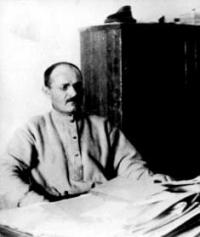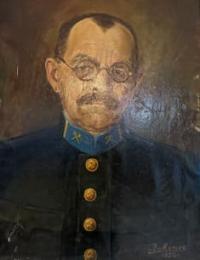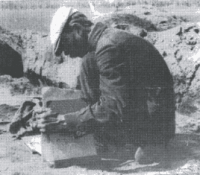You are here
Researcher – Nikolai Valukinsky.



Archeological monuments in Ulytau.
“In every business you need to know the history of its development. If the workers of each branch of production, and even better - of each factory, knew how it arose, how it gradually developed, improved production, the workers would work better than they work, with a deeper understanding of the cultural and historical significance of their work, with greater passion."
M. Gorky.
Archaeologists and archeological researchers of Ulytau.
There are cities as symbols: you just need to name them and images appear, behind which there is a story itself. Such is the Russian city of Voronezh, such is the Kazakh city of Zhezkazgan. The capital of the Soviet Black Earth Region and the copper pearl of the USSR were once united by the Great Patriotic War: many Zhezkazgan residents died a heroic death and remained forever in Voronezh land in those terrible and heroic years.
But there is one more thread stretching between these cities - this is the name of a person who made a great contribution to the preservation and study of the historical past of both the Zhezkazgan region and the Voronezh region: Nikolai Vasilyevich Valukinsky.
Fate decreed that a native of the city of Kozlov, Tambov province, spent the last years of his life in Zhezkazgan - a city of copper in the Karaganda region of the Republic of Kazakhstan. Nikolai Vasilyevich was buried there.
“To the researcher of copper mining Zhezkazgan, archaeologist, founder of the geological and mineralogical museum in the village of Rudnik from the team of the Kazakhmys corporation,” is carved on the tombstone of N.V.’s grave. Valukinsky.
The son of serfs, Nikolai Vasilyevich Valukinsky lived a rich life. Nikolai received his primary education in his hometown (now Michurinsk), then studied at the Voronezh Technical Railway School, after which he worked as an employee on the railway, following in the footsteps of his father, who worked on the railway for about 50 years.
In 1905 he took part in a strike. In 1909, N. Valukinsky entered the Kiev Art School. During his studies, he travels a lot around Ukraine and the provinces of the Black Earth Region in order to more fully explore the history and ethnography of these lands and collect antiquities.
His very first articles, devoted to the architectural monuments of Voronezh, and the beginning of his artistic and pedagogical activities also date back to his student years. In 1915 he was drafted into the army and rose to the rank of second lieutenant.
Nikolai Valukinsky joined the ranks of the CPSU (b) in 1918 and from that time worked as a designer in the ranks of the Red Army. For five years he worked in the Red Army as chief of staff of the 12th railway brigade.
During the Civil War, Valukinsky commanded the leading sector on the Southern and Caucasian fronts. After the end of the war he worked as a teacher. He taught at a school for adults, a workshop school, a high school, and a technical school.
He gave lectures and conducted practical classes on archeology at Voronezh University and the Pedagogical Institute. As a technician, he worked as a draftsman, head of a drafting room, head of a team of carpenters at a factory, head of railway laying, head of a construction site, restoration of river bridges, etc.
Nikolai Vasilyevich was always attracted to history. He devoted his entire life to the study of the historical past: he participated in archaeological and ethnographic expeditions and independently carried out excavations, and was a researcher in archeology at a branch of the Academy of Sciences of the Kazakh SSR.
And no matter who Nikolai Vasilyevich worked, no matter where he lived, he was invariably attracted to the images of distant ancestors, the desire to touch the hoary antiquity. Again and again, this desire led the tireless researcher to new discoveries, and in this he saw the meaning of his life: to know what was long gone and pass on his knowledge and experience to his contemporaries.
Since 1926 he has worked at the Voronezh Regional Museum. As director of the museum (he took historical courses in absentia at the Komvuz), Nikolai Vasilyevich wrote many works of a historical and ethnographic nature, based on a survey of monuments in and around Voronezh.
Nikolai Vasilyevich always tried to share his knowledge and acquired experience with young specialists and teaching staff, giving lectures on archeology at universities. For his excellent work, Nikolai Vasilyevich was repeatedly awarded, and in 1941 he was included in the Book of Honor by the Collegium of the People's Commissar of Education.
During the Great Patriotic War N.V. Valukinsky was mobilized to the front line and appointed battalion commander. Extraordinarily gifted by nature, Valukinsky was a designer, builder, teacher, and archaeologist. And this is not a complete list of his activities and hobbies.
Leafing through the pages of Valukinsky’s biography, one is surprised by the diversity of Valukinsky’s interests. But as an artist, Nikolai Vasilyevich deserves a special conversation. Throughout his life, N. Valukinsky remained an artist.
He took part in many art exhibitions in 1918, 1919, 1925, 1929 and 1930. And 1923 became for Nikolai Valukinsky the year of universal recognition as an artist - at the All-Russian Agricultural Exhibition he was awarded a “Diploma of Appreciation” for his ethnographic drawings.
For a long time, Valukinsky taught fine arts in schools and technical colleges. He knew and corresponded with I.E. Repin. Reproductions of Nikolai Valukinsky’s works on historical, archaeological, ethnographic, and industrial topics were published in many works, newspapers, and magazines.
One of Valukinsky’s first illustrations to appear in Voronezh newspapers was a drawing of A.V.’s house. Koltsova. The works of Nikolai Valukinsky the artist are kept in the Art Museum named after I.N. Kramskoy, in the museum of I.S. Nikitin, for whom Valukinsky made the bookplate. In addition to the Voronezh repositories, his works were acquired by the Kyiv Taras Shevchenko Museum, the Ostrogorzh Art Gallery, the Moscow Museum of the Revolution, and the Naval Museum in St. Petersburg.
In the historical and production museum named after I. Satpayev of the Kazakhmys corporation in the city of Zhezkazgan, there are also sketches made by the hand of Nikolai Vasilyevich, paintings written from his sketches.
Each of the works reflects a specific occupation or ritual of the Bronze Age and the Middle Ages or illustrates stages in the history of the Zhezkazgan deposit and its recognition as an industrial region. The museum's archives contain N. Valukinsky's manuscripts, sketches of ore mining and copper smelting sites, images of labor and household tools he found.
Particularly interesting is Nikolai Vasilyevich’s drawing, which depicts the furnaces of an ancient production center in the Milykuduk area, and the remains of these furnaces were discovered by Valukinsky himself.
This is what he says in a letter addressed to the Academy of Sciences of the Kazakh SSR dated August 25, 1948: “Continuing excavations in the Milykuduk tract, I have now installed fifteen furnaces. They all ended up around the well.
Adjacent to the well on the north side is a single room for iron production. In short, now I have a whole old factory yard.” The beginning of the glorious history of the copper ore Zhezkazgan - Ulytau has its roots in the distant depths of the Bronze Age.
Numerous ancient workings, factory yards of the Milykuduk, Sorkuduk and Ainakul tracts, stone and clay dams often accompanied by pit spillways, to which small ditches run from the channels, labor and household tools were discovered and studied by the tireless researcher-enthusiast Nikolai Vasilyevich Valukinsky - the founder of archaeological excavations in Zhezkazgan.
Today, many archaeological monuments of Zhezkazgan have been destroyed: a railway passed through some, and production was launched in the place of others. And if at one time they had not been studied by N.V. Valukinsky, perhaps we would not now have information and finds that are invaluable to science.
But how did Nikolai Vasilyevich end up in Zhezkazgan? In the hope that his father would take a break from his creative plans, he was invited to Zhezkazgan by his eldest daughter Natalya, who worked as a geologist in the Zhezkazgan integrated geological exploration expedition (the youngest at that time was a student at the Institute of Water Transport Engineers).
Since June 1945, Valukinsky worked at the Zhezkazgan plant as a hydrological technician, while at the same time devoting all his free time to studying the history of Zhezkazgan. The land, rich in monuments of past centuries, only fueled Valukinsky’s passion for comprehending unknown secrets and new finds with renewed vigor.
He did a great job of restoring the past of the steppe region. Walking around the area on foot, Valukinsky made schematic plans of the location of ancient sites and the placement of material on the territory of some of them, important for understanding the processes of ore mining and metallurgy of ancient eras, sketches of ceramic products, agricultural devices, images of labor tools, drawings of ore mining sites, etc.
He discovered 92 Neolithic sites. Valukinsky provided data on his work in the field of archeology in the form of reports, proposals, plans, estimates to the Institute of History, archeology and ethnography Valukinsky (part of the correspondence has been preserved).
Advocating for the protection of monuments on the territory of Zhezkazgan in connection with the large volumes of ongoing construction of a reservoir and industrial enterprises, he proposed holding lectures and conversations with those involved in construction about the importance of their role in the preservation of monuments and archaeological material.
All this was discussed at the level of the Academy of Sciences of the Kazakh SSR with representatives of history, archeology and ethnography. The number and variety of ancient tools of labor and everyday life collected by N. Valukinsky in a relatively small area is amazing: a collection of arrowheads and spears from the Stone Age, stone chippers, hoes, mortars for crushing, sharpening and grinding stones of the Bronze Age, and most importantly - copper smelting furnaces of the era early Middle Ages in the Milykuduk region.
According to researchers, ancient miners extracted about one million tons of ore from these lands. The rich archaeological material collected by Valukinsky, as well as samples of ores, rocks and minerals of the Zhezkazgan deposit, formed the basis of the geological and mineralogical museum created by him and opened for viewing in December 1947 in the village of Rudnik (Zhezkazgan), which after the death of Nikolai Vasilyevich, including same year (1950), with the assistance of the President of the AK KazSSR Kanysh Satpayev, the name of its founder was given.
Nikolai Vasilyevich Valukinsky personally selected spherical nodules and samples of conglomerates from the hills. Subsequently, geologists systematically replenished the museum with interesting specimens. The Book of Reviews contains an assessment of the museum made by the Vice-President of the USSR Academy of Sciences I. Bardin, Professor N. Kassin, Professor A.A. Ivanov, Minister of Geology and Subsoil Protection of the USSR A. Sidorenko, scientific staff of the USSR Academy of Sciences, representatives of the Central Committee of the Communist Party of Kazakhstan, top officials of the Ministry of Non-ferrous Metallurgy, etc.
And here is the note left by the President of the Academy of Sciences of the Kazakh SSR, academician K.I. Satpayev, after visiting the museum in 1961: “The Mining and Geological Museum of the Dzhezkazgan Mine undoubtedly represents one of the most striking achievements of the geologists of Dzhezkazgan.
It has already systematized sections on the mineralogy of ores according to the geological reserves of the deposit, and work has also begun on systematizing the rocks of the Dzhezkazgan section. There is no such museum yet in any non-ferrous metallurgy mine in Kazakhstan. I am very happy and sincerely wish the mining geologists of Dzhezkazgan further success in this important scientific endeavor.”
Now this unique collection of underground riches of the Great Steppe, sparkling with all the colors of the rainbow, collected during the development of the Zhezkazgan deposit, together with objects of copper and bronze culture that were once in the museum of the village of Rudnik, “migrated” to the Historical and Industrial Museum named after K.I. Satpayev corporation “ Kazakhmys”, which was a worthy successor to the mine museum and has existed since 1997.
The yellowed pages of post-war newspapers contain articles by Nikolai Valukinsky; “From the history of ore Dzhezkazgan”, “Artificial oases”, “Ancient sites”. The most interesting and educational is his work “Ancient copper production in the Dzhezkazgan region.”
All this is carefully stored in the archives of the museum of the Kazakhmys corporation in Zhezkazgan. Valukinsky lived in Zhezkazgan for only five years, but during this short period of time he made a truly invaluable contribution to the study of the ancient history of the region.
Valukinsky's opinion was always respected. Thus, academician Alkey Margulan in his book “Begazy-Dandybaevskaya culture of Central Kazakhstan”, describing the Zhezkazgan group of monuments, constantly refers to the diaries of Nikolai Vasilyevich, and cites the characteristics of the stone and metal material of ancient sites made by Valukinsky. “...We owe everything that we know about the settlement of Mila-Kuduk (as well as about other monuments of Zhezkazgan) to the tireless activity of N.V. Valukinsky,” writes Alkey Khakanovich.
On October 10, 1998, the museum and exhibition complex of the Kazakhmys corporation was named after Nikolai Vasilyevich Valukinsky.
List of scientific works, articles, notes and inventions of N.V. Valukinsky:
1. Cloth factories of serfdom. Voronezh, 1926
2. Material for the architecture of the village of Voronezh district. Voronezh
3. Primitives from the village. Voronezh.
4. Slavic fortifications. Historical magazine. Moscow.
5. Landowners in robes. Voronezh.
6. Bronze Age sites. Soviet archeology. Leningrad.
7. Talaki village. Voronezh.
8. Ukrainians in the Voronezh region. Voronezh.
9. In the footsteps of ancient ancestors. Voronezh.
10. K.A. Trutovsky. Kyiv.
11. Easter eggs. Kyiv.
12. Excursion to the village of Moskovskoye. Moscow.
13. Archaeological excavations along the Chu River. Printed by the Kyrgyz branch of the Academy of Sciences.
14. Excavations in the Milykuduk tract in the southern part of the Dzhezkazgan mine. News of the Academy of Sciences of the KazSSR. Archaeological series. 1949, issue 2.
15. From the history of ore Dzhezkazgan.
16. Ancient sites (along Dzhezkazgan-Ulytau).
17. Ancient copper production in the Dzhezkazgan region. News of the Academy of Sciences of the KazSSR. Archaeological series. 1948, issue 1.
18. Artificial oases (along Dzhezkazgan-Ulytau)
19. Ancient mining in our region (according to Dzhezkazgan-Ulytau).
Inventions N.V. Valukinsky published in COT:
1. Profilograph.
2. Triotrograph.
3. Machine for drying drawings.
Today, these are modern cities, each with their own history, which museums are primarily called upon to preserve, perpetuate and convey to people. This is Zhezkazgan. Steppe expanses, factories and factories burning in the sun, copper. And most importantly, a difficult, but interesting fate.
At the IPM, along with scientific material from Valukinsky’s research (some of it was included in the museum’s exhibition), there are also works by Karaganda artists made according to Valukinsky’s sketches. Drawings, as well as paintings created by an inquisitive researcher, make it possible to visualize the work of ancient miners, enrichers, metallurgists, and the life of nomadic hunters.
A guide to the museum along with sketches of equipment for the designed museum, made by Valukinsky’s hand, exposition plans, museum work plans. Drawings, sketches: the entrance to the adit, the first mines of Dzhezkazgan, maps of the location of ancient sites in Dzhezkazgan, old drifts, mining sites, chigir, sketches of ceramic products and individual pieces of ceramics.
Album of drawings, hand-designed “Mining and metallurgy since ancient times”. Description and sketches of rock paintings in the valley of the Bulanta River, near the village of Baikonur. Biographical information about Valukinskaya’s wife Elena Alexandrovna, daughters Evgenia and Natalya, granddaughters and great-grandsons of Nikolai Vasilyevich
Authority:
Olga Golikova. “Tireless researcher - Nikolai Valukinsky (1886 – 1950).
Photos by:
provided by Olga Golikova and from the funds of the Historical and Industrial Museum named after K.I. Satpayeva. Town of Zhezkazgan.







